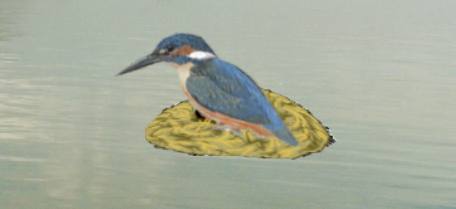 |
 |
| Home | Welcome | What's New | Site Map | Glossary | Weather Doctor Amazon Store | Book Store | Accolades | Email Us |
 | |||||||||
Weather Almanac for December 2002HALCYON DAYS OF DECEMBERDecember 14th marks the start of the Halcyon Days of December.The Halcyon Days encompass the fourteen-day period centered on the Winter Solstice when the sea is commanded to be calm and the wind light by none other than Aeolus, keeper of the winds and one of the lesser Greek deities. In the Mediterranean region where this belief originated, the weather is typically calm around the time of the Winter Solstice. What exactly are the Halcyon Days? My dictionary refers to halcyon as meaning joyful and carefree, peaceful and prosperous, and, in relation to the weather: fair and stormless. Now, we in North America generally do not think of this two-week period around Christmas as particularly fair weather-prone. Indeed, we wish for just that one storm to bring us a white Christmas, but we fear periods of storminess will upset our holiday travel plans. The Halcyon Days are not only associated with a stretch of calm seas and good weather but also with the kingfisher, a bird from an avian family found around the world. (In Australia, the family tree includes the kookaburra, famous for its laughing cry.) The kingfisher species of interest here is the European kingfisher, an unmistakable bird with brilliant plumage and a long, dagger-like bill.
The ancients, however, had a very different notion as to its nesting habits. They believed kingfishers built floating nests made of fish bones on the sea. Further, wherever a nest carrying a female and her eggs drifted, the sea and winds would be becalmed. Thus, the ancient mariner held kingfishers extremely sacred, and a dried kingfisher body was often carried as a talisman against lightning. There are several legends/myths surrounding the kingfisher and weather. The one I will focus on first connects the bird with the Halcyon Days. The bird's classic name - the halcyon or alcyon - derives from Alcyone or Halcyone who, in Greek mythology, was the daughter of Aeolus.
When Ceyx lost his brother, he felt the gods had turned hostile toward him. He decided, therefore, to voyage to Ionia, there to consult the oracle of Apollo. Alcyone tried desperately to persuade him to forego the trip. She had grown up in the palace of the King of the Winds and thus knew well the violence of the winds at sea. "They rush together," she cried, "with such fury that fire flashes from the conflict." Though her words weighed heavily on King Ceyx, he would not be dissuaded. With tears and sobs she bade him farewell, then fell senseless to the ground in grief as he boarded the ship and departed. The first night out, the east wind began to blow a gale and amid the roar of the thunder, the swelling sea lifted to the heavens, scattering its foam among the clouds, then dropped away to the deep sea bottom. According to Bullfinch's Mythology: "Rain falls in torrents, as if the skies were coming down to unite with the sea. When the lightning ceases for a moment, the night seems to add its own darkness to that of the storm; then comes the flash, rending the darkness asunder, and lighting up all with a glare....Presently the mast is shattered by a stroke of lightning, the rudder broken, and the triumphant surge curling over looks down upon the wreck, then falls, and crushes it to fragments. Some of the seamen, stunned by the stroke, sink, and rise no more; others cling to fragments of the wreck. Ceyx, with the hand that used to grasp the sceptre, holds fast to a plank, calling for help,- alas, in vain,-upon his father and his father-in-law. But oftenest on his lips was the name of Halcyone. To her his thoughts cling. He prays that the waves may bear his body to her sight, and that it may receive burial at her hands. At length the waters overwhelm him, and he sinks. The Day-star looked dim that night. Since it could not leave the heavens, it shrouded its face with clouds." When her husband's body appeared before her floating toward shore, Alcyone, filled with grief, threw herself into the sea. But before she hit water, she changed instantly into a bird. As she flew skimming along the water surface toward the lifeless body, her throat poured forth sounds full of grief, her voice, lamentation. When she touched Ceyx's mute and bloodless body, she enfolded it with her new-formed wings, and tried to kiss it with her horny beak. Feeling her deep grief, the gods out of pity changed the couple into a pair of kingfishers. Ovid in Metamorphoses told us: "Their love lived on, nor in these birds were marriage bonds dissolved, and they soon coupled and were parent birds." Ever since, the legend goes, Alcyone carries her dead mate to his burial, then builds a nest and launches it out to sea. There, she lays her eggs and hatches her chicks, brooding over her sea-borne nest for seven placid days before the Winter Solstice and seven becalmed days after. While she is brooding, the sea is held unusually calm, for to protect Alcyone and his grandchildren, According to Ovid, "the passage of the deep is free from storms, throughout those seven full days; and Aeolus restraining harmful winds, within their cave, for his descendants' sake gives halcyon seas." Thus, in this winter month, wrote Simonides of Ceos, he "brings calm to fourteen days that earthlings call the time when the wind is forgotten, the holy breeding-season of the many-coloured alcyon." For this reason, mariners credit the kingfisher, or "alcyon bird," with the power to calm storms and raging seas.  Myth of Alcone says kingfishers nest on sea surface held calm by Aeoleus The legend of the great love between Alcyone and Ceyx, inspired many. Three immortal English poets have written about the event. William Shakespeare refers to it in this passage from Hamlet: John Milton wrote in On the Morning of Christ's Nativity: And John Keats referred to the kingfisher in Endymion: Other LegendsThere was, however, another Alcyone in mythology. This Alcyone was the daughter of Pleione ("the sailing queen") and leader of the seven Pleiades. Since the Mediterranean navigational year began with the rising of the Pleiades in May and ended when they set, there arose a belief in a goddess who protected sailors from storms. The kingfisher was linked to this Alcyone as well.  The Seven Sisters Stars of the Pleiades Constellation A medieval Biblical legend also concerns the kingfisher and links it to the weather and sky. The legend names it as the second bird Noah sent out from the Ark to look for land after the rain had stopped. The originally grey bird flew so carelessly high into the sky that her back turned blue and so close to the sun that she scorched her breast. The female kingfisher thereafter sports a rust-coloured band across her breast and a blue upper body. The cousin to the European kingfisher here on Vancouver Island is the belted kingfisher. Many island residents along coastal British Columbia hope that the halcyon powers have rubbed off on our kingfisher. The Winter Solstice is a prime time for storminess along the Pacific Northwest coast, and many who travel for the holidays must rely at some point on the ferry service to travel between the mainland and islands or among the islands. Calm waters make for smooth holiday sailings. Written by
|
|||||||||
 |
To Purchase Notecard, |
Now Available! Order Today! | |
 |
 |
NEW! Now |
The BC Weather Book: |


